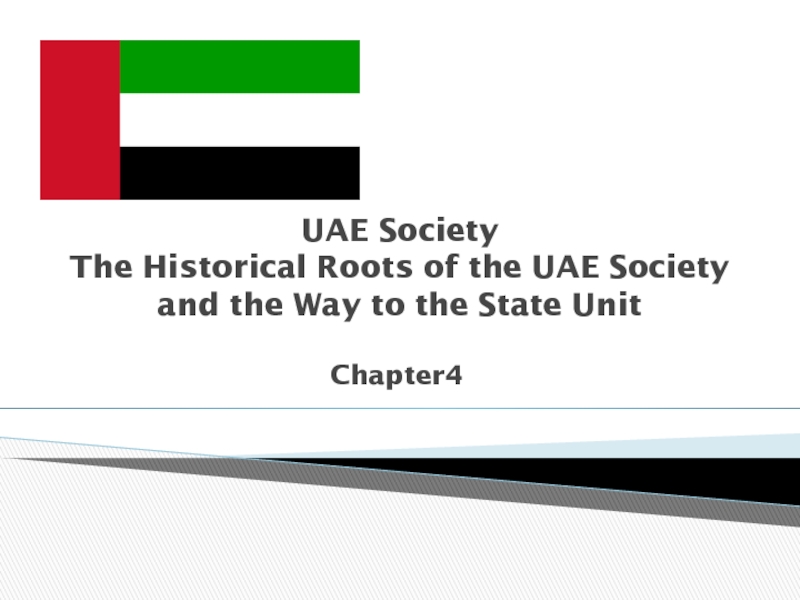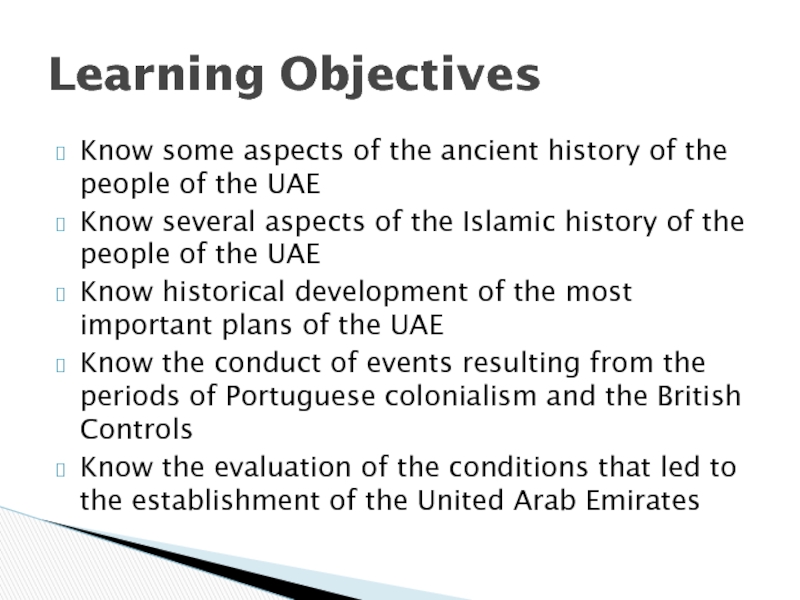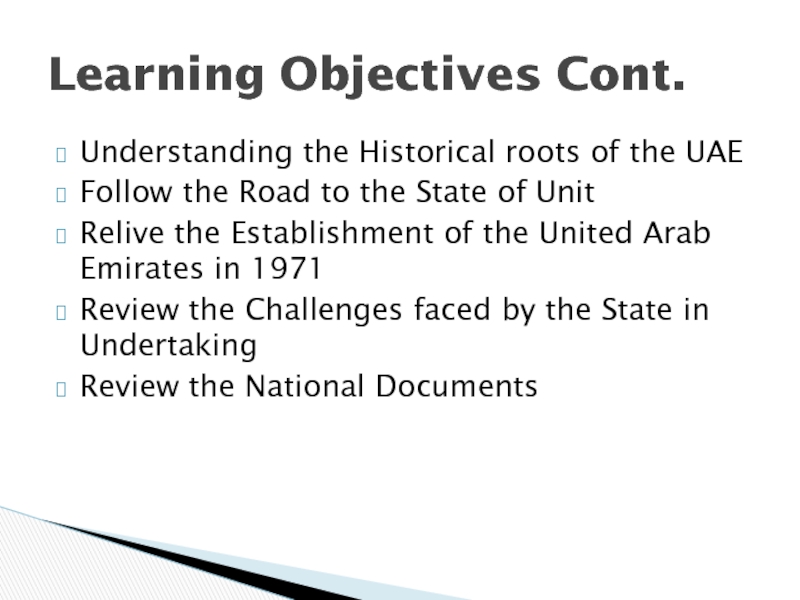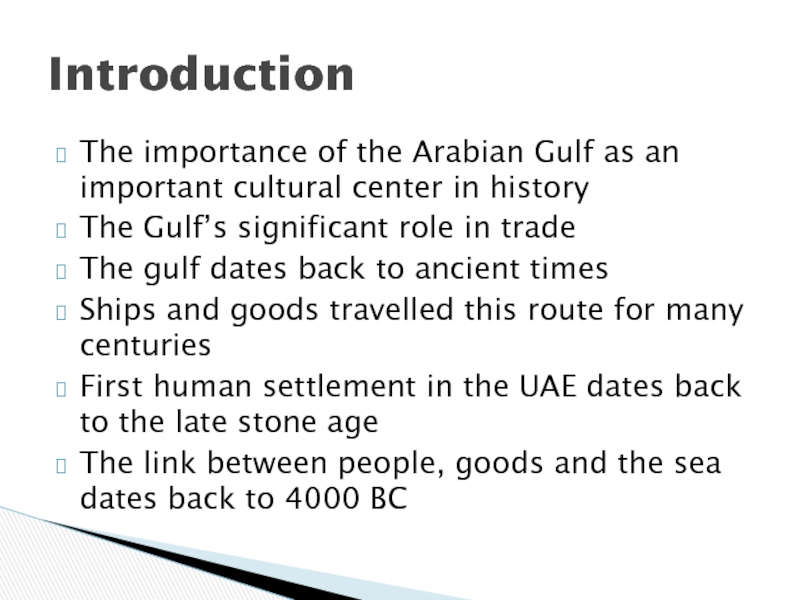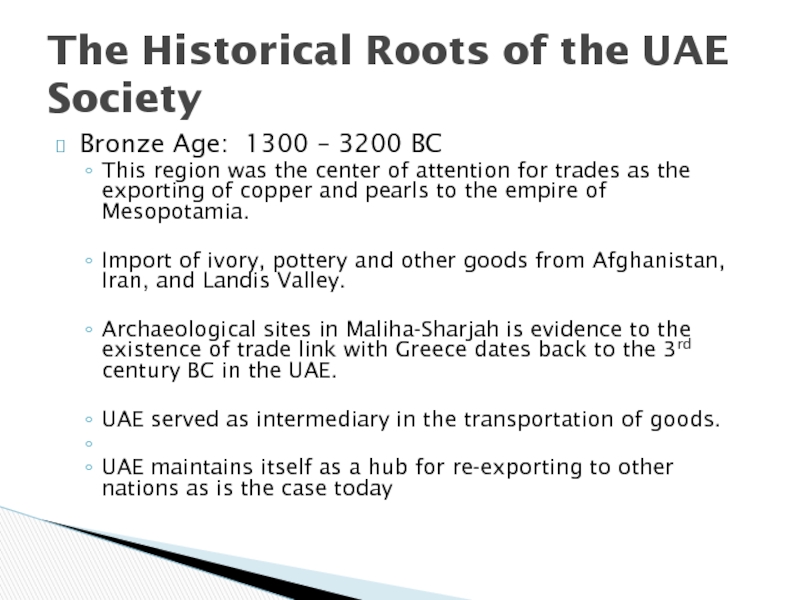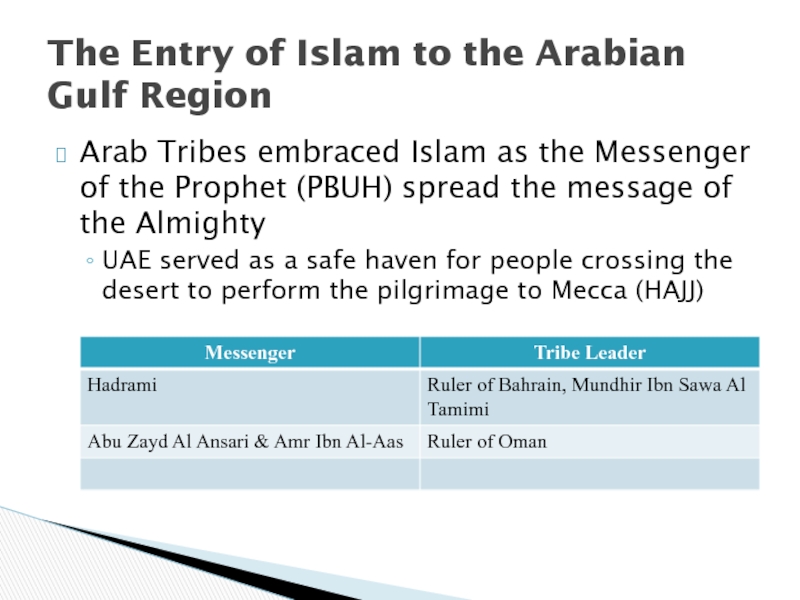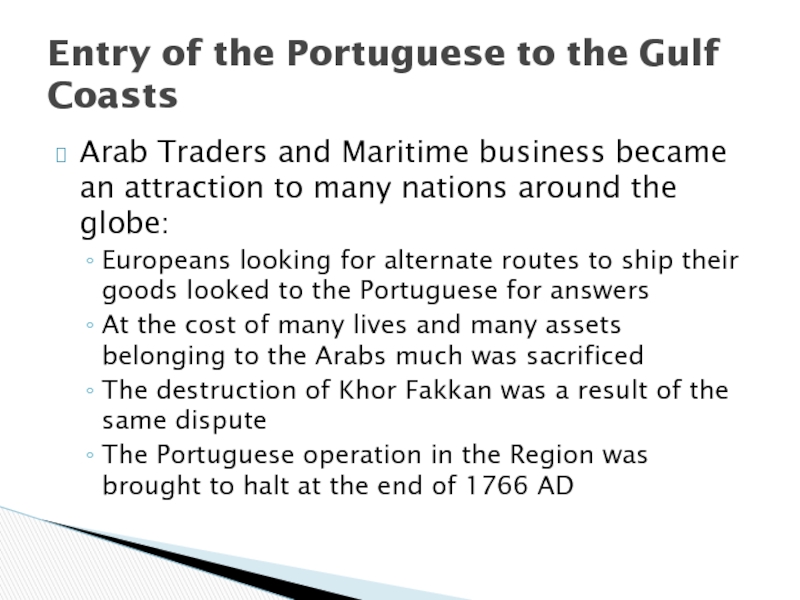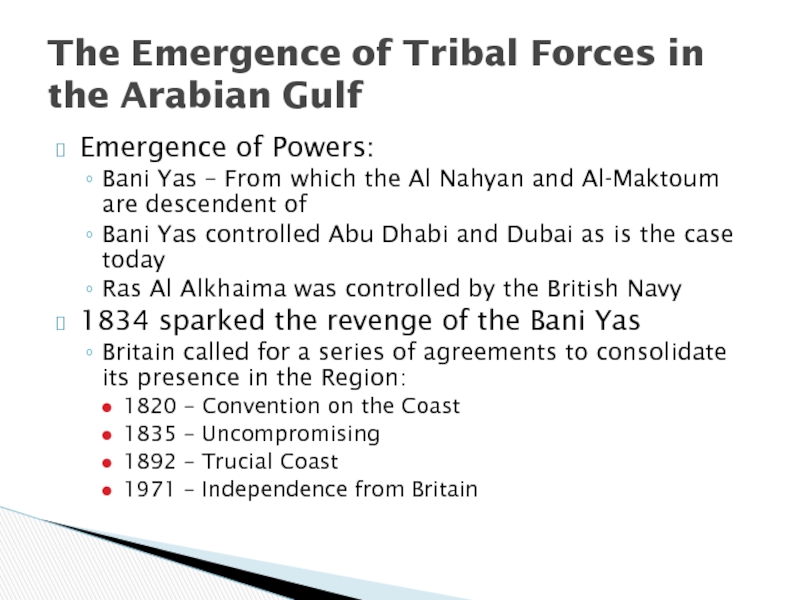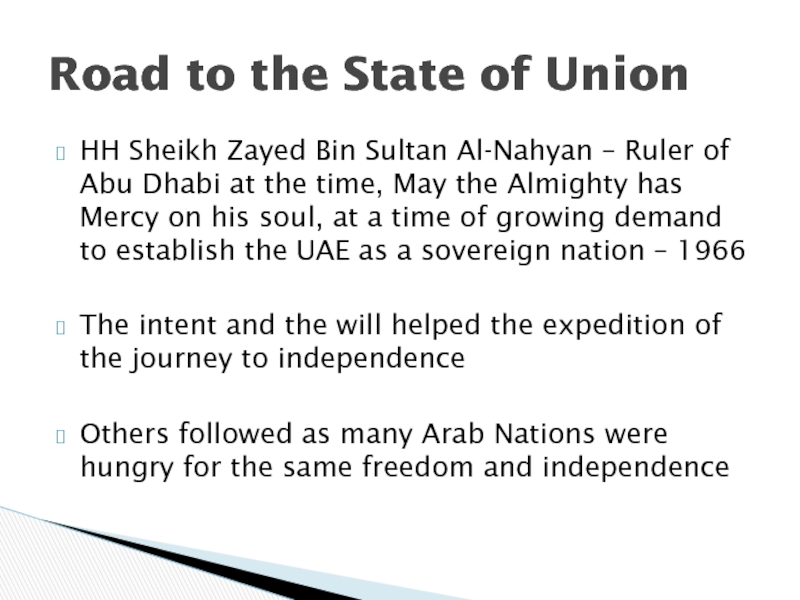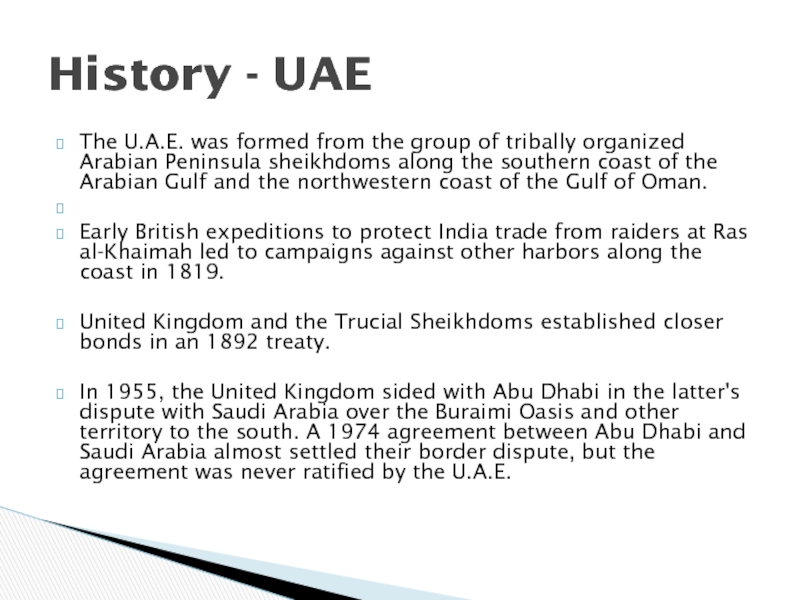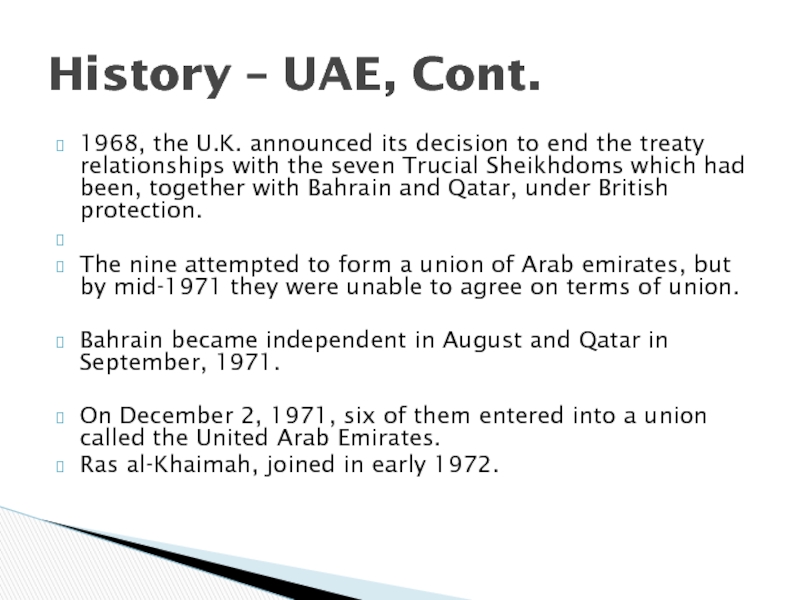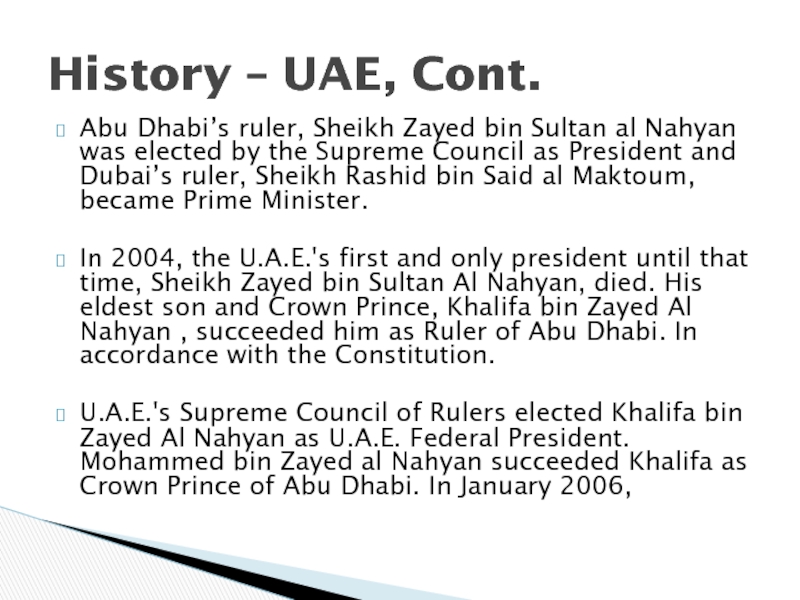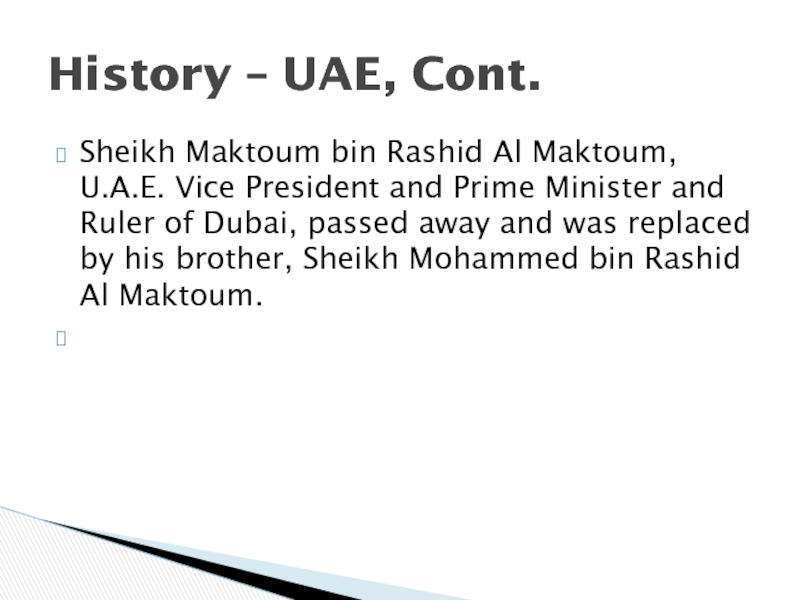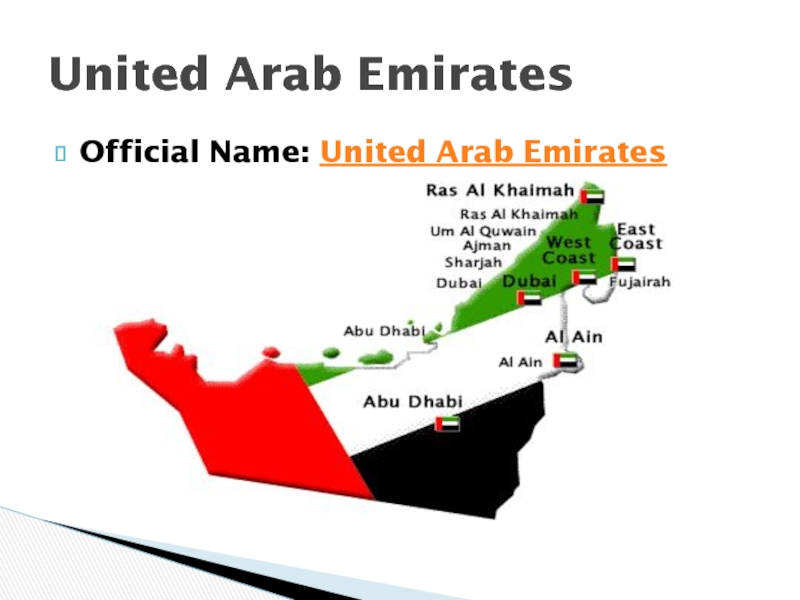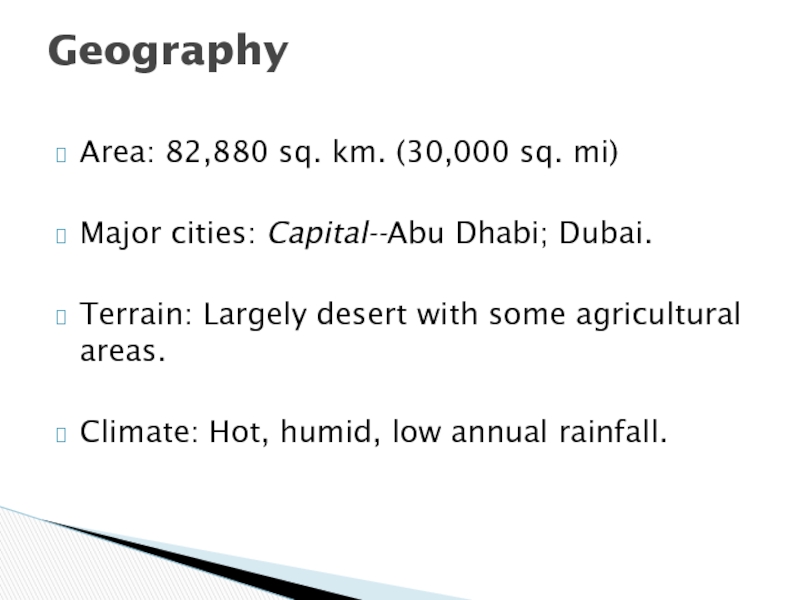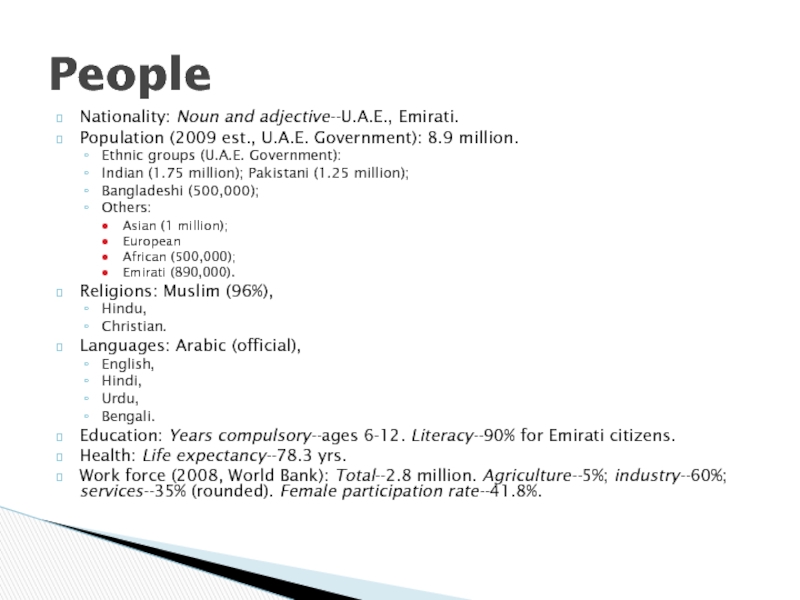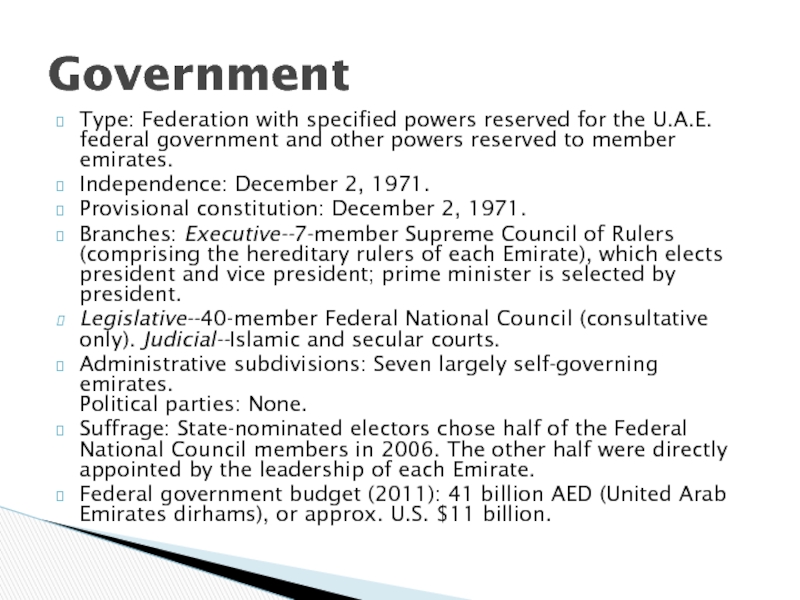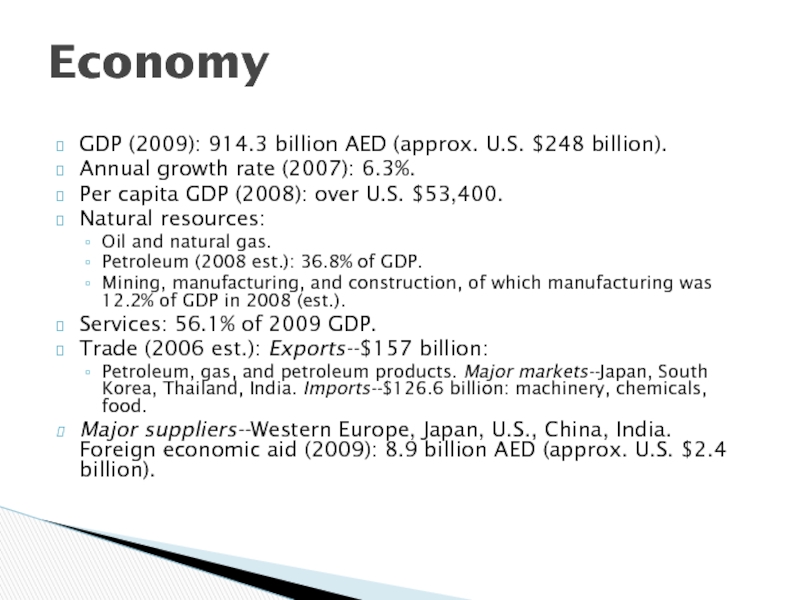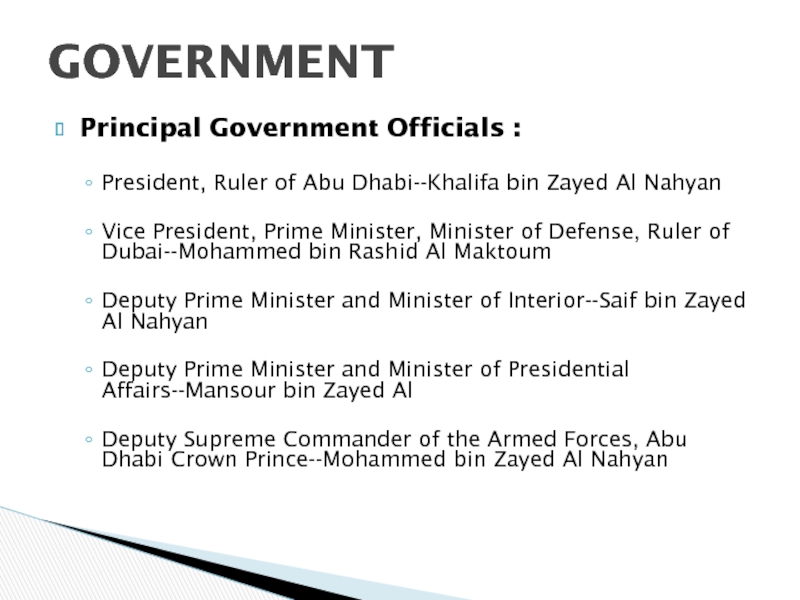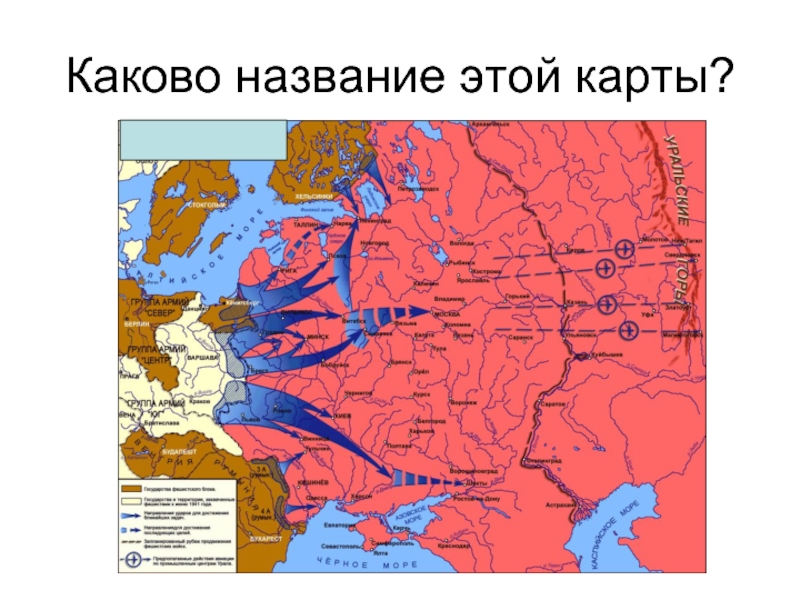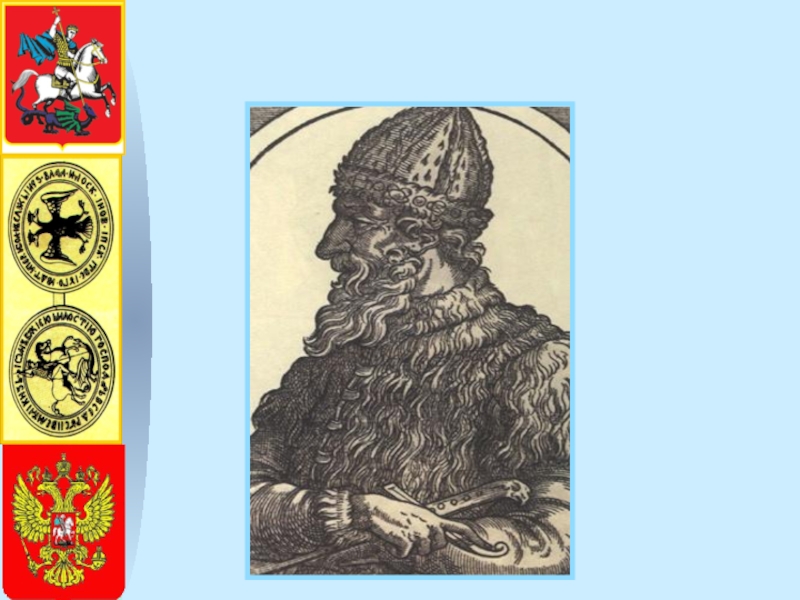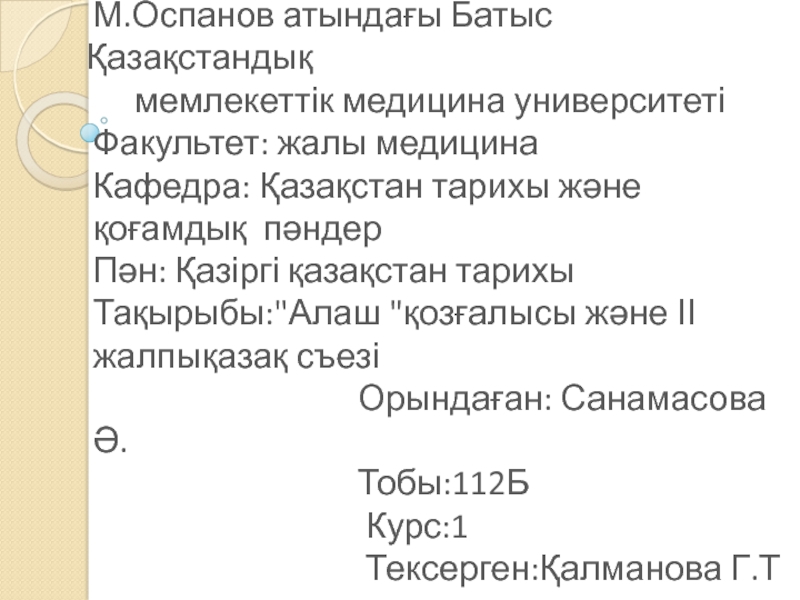Chapter4
- Главная
- Разное
- Дизайн
- Бизнес и предпринимательство
- Аналитика
- Образование
- Развлечения
- Красота и здоровье
- Финансы
- Государство
- Путешествия
- Спорт
- Недвижимость
- Армия
- Графика
- Культурология
- Еда и кулинария
- Лингвистика
- Английский язык
- Астрономия
- Алгебра
- Биология
- География
- Детские презентации
- Информатика
- История
- Литература
- Маркетинг
- Математика
- Медицина
- Менеджмент
- Музыка
- МХК
- Немецкий язык
- ОБЖ
- Обществознание
- Окружающий мир
- Педагогика
- Русский язык
- Технология
- Физика
- Философия
- Химия
- Шаблоны, картинки для презентаций
- Экология
- Экономика
- Юриспруденция
The historical roots of the UAE society and the way to the state unit. (Chapter4) презентация
Содержание
- 1. The historical roots of the UAE society and the way to the state unit. (Chapter4)
- 2. Know some aspects of the ancient history
- 3. Understanding the Historical roots of the UAE
- 4. The importance of the Arabian Gulf as
- 5. Bronze Age: 1300 – 3200 BC This
- 6. Arab Tribes embraced Islam as the Messenger
- 7. Arab Traders and Maritime business became an
- 8. Emergence of Powers: Bani Yas – From
- 9. HH Sheikh Zayed Bin Sultan Al-Nahyan –
- 10. The U.A.E. was formed from the group
- 11. 1968, the U.K. announced its decision to
- 12. Abu Dhabi’s ruler, Sheikh Zayed bin Sultan
- 13. Sheikh Maktoum bin Rashid Al Maktoum, U.A.E.
- 14. Official Name: United Arab Emirates United Arab Emirates
- 15. Area: 82,880 sq. km. (30,000 sq. mi)
- 16. Nationality: Noun and adjective--U.A.E., Emirati. Population (2009
- 17. Type: Federation with specified powers reserved for
- 18. GDP (2009): 914.3 billion AED (approx.
- 19. Principal Government Officials : President, Ruler
Слайд 2Know some aspects of the ancient history of the people of
Know several aspects of the Islamic history of the people of the UAE
Know historical development of the most important plans of the UAE
Know the conduct of events resulting from the periods of Portuguese colonialism and the British Controls
Know the evaluation of the conditions that led to the establishment of the United Arab Emirates
Learning Objectives
Слайд 3Understanding the Historical roots of the UAE
Follow the Road to the
Relive the Establishment of the United Arab Emirates in 1971
Review the Challenges faced by the State in Undertaking
Review the National Documents
Learning Objectives Cont.
Слайд 4The importance of the Arabian Gulf as an important cultural center
The Gulf’s significant role in trade
The gulf dates back to ancient times
Ships and goods travelled this route for many centuries
First human settlement in the UAE dates back to the late stone age
The link between people, goods and the sea dates back to 4000 BC
Introduction
Слайд 5Bronze Age: 1300 – 3200 BC
This region was the center of
Import of ivory, pottery and other goods from Afghanistan, Iran, and Landis Valley.
Archaeological sites in Maliha-Sharjah is evidence to the existence of trade link with Greece dates back to the 3rd century BC in the UAE.
UAE served as intermediary in the transportation of goods.
UAE maintains itself as a hub for re-exporting to other nations as is the case today
The Historical Roots of the UAE Society
Слайд 6Arab Tribes embraced Islam as the Messenger of the Prophet (PBUH)
UAE served as a safe haven for people crossing the desert to perform the pilgrimage to Mecca (HAJJ)
The Entry of Islam to the Arabian Gulf Region
Слайд 7Arab Traders and Maritime business became an attraction to many nations
Europeans looking for alternate routes to ship their goods looked to the Portuguese for answers
At the cost of many lives and many assets belonging to the Arabs much was sacrificed
The destruction of Khor Fakkan was a result of the same dispute
The Portuguese operation in the Region was brought to halt at the end of 1766 AD
Entry of the Portuguese to the Gulf Coasts
Слайд 8Emergence of Powers:
Bani Yas – From which the Al Nahyan and
Bani Yas controlled Abu Dhabi and Dubai as is the case today
Ras Al Alkhaima was controlled by the British Navy
1834 sparked the revenge of the Bani Yas
Britain called for a series of agreements to consolidate its presence in the Region:
1820 – Convention on the Coast
1835 – Uncompromising
1892 – Trucial Coast
1971 – Independence from Britain
The Emergence of Tribal Forces in the Arabian Gulf
Слайд 9HH Sheikh Zayed Bin Sultan Al-Nahyan – Ruler of Abu Dhabi
The intent and the will helped the expedition of the journey to independence
Others followed as many Arab Nations were hungry for the same freedom and independence
Road to the State of Union
Слайд 10The U.A.E. was formed from the group of tribally organized Arabian
Early British expeditions to protect India trade from raiders at Ras al-Khaimah led to campaigns against other harbors along the coast in 1819.
United Kingdom and the Trucial Sheikhdoms established closer bonds in an 1892 treaty.
In 1955, the United Kingdom sided with Abu Dhabi in the latter's dispute with Saudi Arabia over the Buraimi Oasis and other territory to the south. A 1974 agreement between Abu Dhabi and Saudi Arabia almost settled their border dispute, but the agreement was never ratified by the U.A.E.
History - UAE
Слайд 111968, the U.K. announced its decision to end the treaty relationships
The nine attempted to form a union of Arab emirates, but by mid-1971 they were unable to agree on terms of union.
Bahrain became independent in August and Qatar in September, 1971.
On December 2, 1971, six of them entered into a union called the United Arab Emirates.
Ras al-Khaimah, joined in early 1972.
History – UAE, Cont.
Слайд 12Abu Dhabi’s ruler, Sheikh Zayed bin Sultan al Nahyan was elected
In 2004, the U.A.E.'s first and only president until that time, Sheikh Zayed bin Sultan Al Nahyan, died. His eldest son and Crown Prince, Khalifa bin Zayed Al Nahyan , succeeded him as Ruler of Abu Dhabi. In accordance with the Constitution.
U.A.E.'s Supreme Council of Rulers elected Khalifa bin Zayed Al Nahyan as U.A.E. Federal President. Mohammed bin Zayed al Nahyan succeeded Khalifa as Crown Prince of Abu Dhabi. In January 2006,
History – UAE, Cont.
Слайд 13Sheikh Maktoum bin Rashid Al Maktoum, U.A.E. Vice President and Prime
History – UAE, Cont.
Слайд 15Area: 82,880 sq. km. (30,000 sq. mi)
Major cities: Capital--Abu Dhabi; Dubai.
Terrain:
Climate: Hot, humid, low annual rainfall.
Geography
Слайд 16Nationality: Noun and adjective--U.A.E., Emirati.
Population (2009 est., U.A.E. Government): 8.9 million.
Ethnic
Indian (1.75 million); Pakistani (1.25 million);
Bangladeshi (500,000);
Others:
Asian (1 million);
European
African (500,000);
Emirati (890,000).
Religions: Muslim (96%),
Hindu,
Christian.
Languages: Arabic (official),
English,
Hindi,
Urdu,
Bengali.
Education: Years compulsory--ages 6-12. Literacy--90% for Emirati citizens.
Health: Life expectancy--78.3 yrs.
Work force (2008, World Bank): Total--2.8 million. Agriculture--5%; industry--60%; services--35% (rounded). Female participation rate--41.8%.
People
Слайд 17Type: Federation with specified powers reserved for the U.A.E. federal government
Independence: December 2, 1971.
Provisional constitution: December 2, 1971.
Branches: Executive--7-member Supreme Council of Rulers (comprising the hereditary rulers of each Emirate), which elects president and vice president; prime minister is selected by president.
Legislative--40-member Federal National Council (consultative only). Judicial--Islamic and secular courts.
Administrative subdivisions: Seven largely self-governing emirates. Political parties: None.
Suffrage: State-nominated electors chose half of the Federal National Council members in 2006. The other half were directly appointed by the leadership of each Emirate.
Federal government budget (2011): 41 billion AED (United Arab Emirates dirhams), or approx. U.S. $11 billion.
Government
Слайд 18
GDP (2009): 914.3 billion AED (approx. U.S. $248 billion).
Annual growth rate
Per capita GDP (2008): over U.S. $53,400.
Natural resources:
Oil and natural gas.
Petroleum (2008 est.): 36.8% of GDP.
Mining, manufacturing, and construction, of which manufacturing was 12.2% of GDP in 2008 (est.).
Services: 56.1% of 2009 GDP.
Trade (2006 est.): Exports--$157 billion:
Petroleum, gas, and petroleum products. Major markets--Japan, South Korea, Thailand, India. Imports--$126.6 billion: machinery, chemicals, food.
Major suppliers--Western Europe, Japan, U.S., China, India. Foreign economic aid (2009): 8.9 billion AED (approx. U.S. $2.4 billion).
Economy
Слайд 19Principal Government Officials :
President, Ruler of Abu Dhabi--Khalifa bin Zayed Al
Vice President, Prime Minister, Minister of Defense, Ruler of Dubai--Mohammed bin Rashid Al Maktoum
Deputy Prime Minister and Minister of Interior--Saif bin Zayed Al Nahyan
Deputy Prime Minister and Minister of Presidential Affairs--Mansour bin Zayed Al
Deputy Supreme Commander of the Armed Forces, Abu Dhabi Crown Prince--Mohammed bin Zayed Al Nahyan
GOVERNMENT
